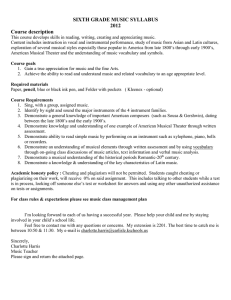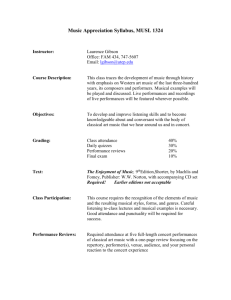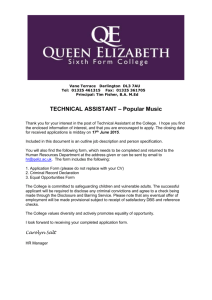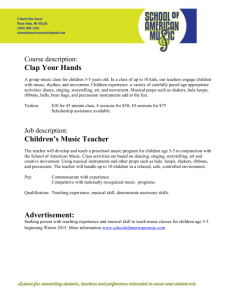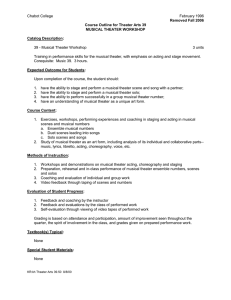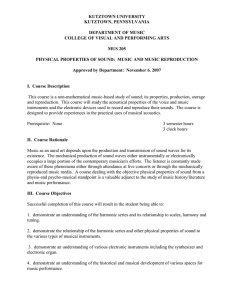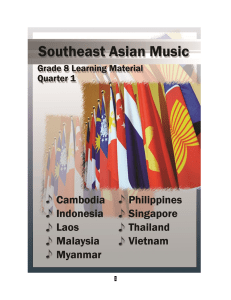Creating Music for Readers Theater
advertisement
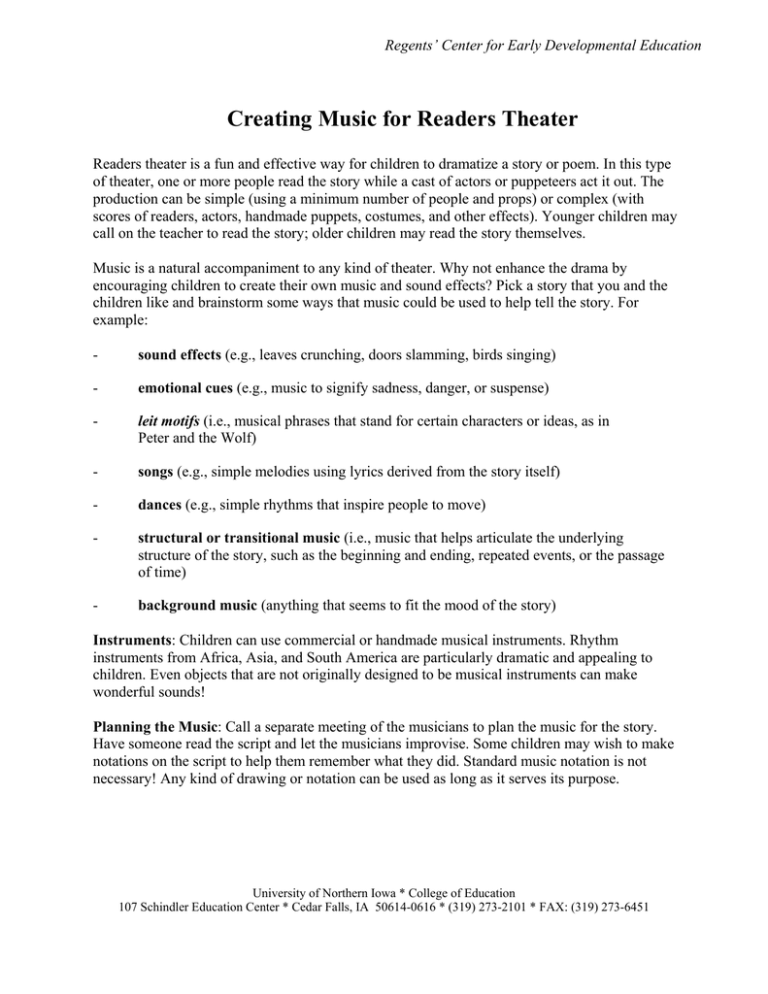
Regents’ Center for Early Developmental Education Creating Music for Readers Theater Readers theater is a fun and effective way for children to dramatize a story or poem. In this type of theater, one or more people read the story while a cast of actors or puppeteers act it out. The production can be simple (using a minimum number of people and props) or complex (with scores of readers, actors, handmade puppets, costumes, and other effects). Younger children may call on the teacher to read the story; older children may read the story themselves. Music is a natural accompaniment to any kind of theater. Why not enhance the drama by encouraging children to create their own music and sound effects? Pick a story that you and the children like and brainstorm some ways that music could be used to help tell the story. For example: - sound effects (e.g., leaves crunching, doors slamming, birds singing) - emotional cues (e.g., music to signify sadness, danger, or suspense) - leit motifs (i.e., musical phrases that stand for certain characters or ideas, as in Peter and the Wolf) - songs (e.g., simple melodies using lyrics derived from the story itself) - dances (e.g., simple rhythms that inspire people to move) - structural or transitional music (i.e., music that helps articulate the underlying structure of the story, such as the beginning and ending, repeated events, or the passage of time) - background music (anything that seems to fit the mood of the story) Instruments: Children can use commercial or handmade musical instruments. Rhythm instruments from Africa, Asia, and South America are particularly dramatic and appealing to children. Even objects that are not originally designed to be musical instruments can make wonderful sounds! Planning the Music: Call a separate meeting of the musicians to plan the music for the story. Have someone read the script and let the musicians improvise. Some children may wish to make notations on the script to help them remember what they did. Standard music notation is not necessary! Any kind of drawing or notation can be used as long as it serves its purpose. University of Northern Iowa * College of Education 107 Schindler Education Center * Cedar Falls, IA 50614-0616 * (319) 273-2101 * FAX: (319) 273-6451 Regents’ Center for Early Developmental Education Performing the Music: Some children may choose to tape record the words and music and then play the tape for the actors or puppeteers. Others may prefer to give live performances. Recorded words and music have the advantage of being reliable (e.g., they sound the same every time). Live performances, while more variable, may potentially be more exciting (especially when exotic instruments are involved). The choice is up to you. The main thing is that everyone is actively and creatively involved ---and that it is FUN! - Educational Rationale Musical Development: Provides opportunities for children to explore musical sounds, different ways to express emotion and meaning in music, and practical ways to use musical notation. - Language and Literacy: Encourages children to attend to the structure, meaning, and/or emotional content of a story or poem. - Social Development: Creates a context in which children can share ideas and work collaboratively to achieve common goal. Constructivist Education Constructivist education promotes learning and development by engaging children in interesting activities that inspire active experimentation with all its groping and error. These activities stimulate children to invent new problems and new solutions. Teachers foster cooperation between adults and children and among children themselves in a classroom atmosphere based upon mutual respect. This educational environment fosters children’s self-regulation, assumption of responsibility, and feelings of community, all of which help promote academic learning. Acknowledgements Special thanks are due to the teachers and children of Kingsley and Kittrell Schools in Waterloo, Iowa, for their spirited performances and creative ideas for integrating art, literature, music, and drama into the classroom. For further information: DeVries, R. & Zan, B. (1994). Moral classrooms, moral children: Creating a constructivist atmosphere in early education New York: Teachers College Press. Hildebrandt, C. (1998). Creativity and music in early childhood. Young Children, Vol. 53, No. 6, pp. 6874. Upitis, R. (1990). This, too, is music. Portsmouth, NH: Heinemann. Upitis, R. (1992). Can I play you my song? Portsmouth, NH: Heinemann. University of Northern Iowa * College of Education 107 Schindler Education Center * Cedar Falls, IA 50614-0616 * (319) 273-2101 * FAX: (319) 273-6451



